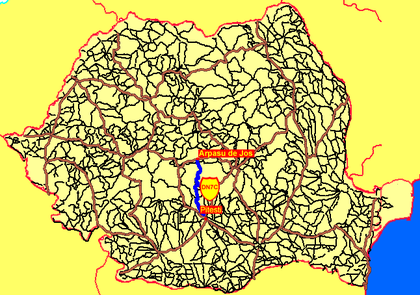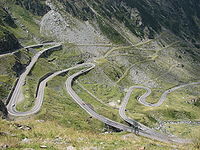- Carretera Transfăgărăşan
-
Coordenadas:
La Transfăgărășan o DN7C es la segunda carretera pavimentada de mayor altitud de Rumania. Construida como ruta militar estratégica, los 90 kilometros de curvas recorren de norte a sur las secciones más altas del sur de los Cárpatos, entre el pico más alto del país, el Moldoveanu, y el segundo más alto, el Negoiu. La carretera conecta las regiones históricas de Transilvania y Wallachia, y las ciudades de Sibiu y Piteşti.
Contenido
Historia
La carretera fue construida entre 1970 y 1974, durante el mandato de Nicolae Ceauşescu. Fue la respuesta a la invasión de Checoslovaquia de 1968 por parte de la Unión Sovietica. Ceaușescu quiso asegurar el rapido acceso militar a traves de las montañas en caso de que la Unión Soviética intentase repetir el movimiento. Consecuentemente, la carretera fue construida pincipalmente por las fuerzas armadas, con un alto coste financiero y humano, pues se usaron cerca de 6.000 toneladas de dinamita solo en la cara norte, y, según informes oficiales, 40 soldados perdieron la vida durante la construcción.
Ruta
La carretera alcanza los 2034 metros de altitud. La Transfăgărăşan es una carretera atractiva y un desafio para todo tipo de conductores. Debido a la topografía, la velocidad media está en torno a los 40 km/h. La carretera da acceso al Lago Bâlea y al Balneario de Bâlea.
The road is usually closed from late October until late June because of snow. Depending on the weather, it may remain open until as late as November. It may also be closed, at times, because of weather conditions (it occasionally snows even in August). There are signs at the town of Curtea de Argeş and the village of Cartisoara that provide information on the passage. Travellers can find food and lodging at several hotels or chalets (cabane) along the way.
It has more tunnels (a total of 5)[1] and viaducts than any other road in Romania. Near the highest point, at Bâlea Lake, the road passes through the longest road tunnel in Romania which is not lighted (884 m).
Among the attractions along the southern section of the road, near the village of Arefu, is the Poienari fortress. The castle served as the residence of Vlad III the Impaler, the prince who inspired Bram Stoker’s Dracula character. There is a parking area and a path to the ruins.
The northern section is used as a part of yearly cyclist competitions Tour of Romania (Romanian: Turul României). The difficulty of this section is considered to be very similar to Hors Categorie climbs (literally beyond categorization) in the Tour de France.
Referencias culturales
- En Septiembre del 2009, el programa de television britanico "Top Gear" filmaron un programa en esta carretera.[2] El segmento apareció en el primer episodio de "Top Gear Series 14", televisado el 15 de Noviembre de 2009. Estaban en el pais por un Grand Tour con un Aston Martin DBS Volante, Ferrari California y un Lamborghini Gallardo LP560-4 Spyder.
- La pelicula Ghost Rider: Spirit of Vengeance, protagonizada por Nicolas Cage and Idris Elba, se grabará en este carretera.[3]
Galería de imágenes
Referencias
Enlaces externos
 Wikimedia Commons alberga contenido multimedia sobre Carretera Transfăgărăşan. Commons
Wikimedia Commons alberga contenido multimedia sobre Carretera Transfăgărăşan. Commons- Virtual Tour – Amazing Transfagarasan road
- Virtual Tour – Transfagarasan Mountain
- Virtual Tour – Transfarasan waterfalls – amazing landscape
- Article about the Transfagarasan road
- Photo gallery,maps,Lake Vidraru, Transfagarasan,Lake Balea
- Transfăgărăşan Photos
- Pictures and images from Fagaras Mountains, including Transfagarasan National Road
- Transfăgărăşan Photo Gallery
- MotoRomania – Galeria fotográfica de la Carretera Transfagarasa y una descripción de la misma
- Fotografias de la Carretera Transfagarasa
- Fotografias nocturnas en la Carretera Transfagarasa
- La Carretera Transfagarasa en invierno
Categoría:- Transporte de Rumania
Wikimedia foundation. 2010.











